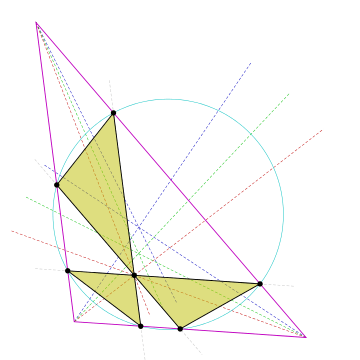Lemoine hexagon
In geometry, the Lemoine hexagon is a cyclic hexagon with vertices given by the six intersections of the edges of a triangle and the three lines that are parallel to the edges that pass through its symmedian point. There are two definitions of the hexagon that differ based on the order in which the vertices are connected.

Area and perimeter
The Lemoine hexagon can be drawn defined in two ways, first as a simple hexagon with vertices at the intersections as defined before. The second is a self-intersecting hexagon with the lines going through the symmedian point as three of the edges and the other three edges join pairs of adjacent vertices.
For the simple hexagon drawn in a triangle with side lengths and area the perimeter is given by
and the area by
For the self intersecting hexagon the perimeter is given by
and the area by
Circumcircle
In geometry, five points determine a conic, so arbitrary sets of six points do not generally lie on a conic section, let alone a circle. Nevertheless, the Lemoine hexagon (with either order of connection) is a cyclic polygon, meaning that its vertices all lie on a common circle. The circumcircle of the Lemoine hexagon is known as the first Lemoine circle.
References
- Casey, John (1888), "Lemoine's, Tucker's, and Taylor's Circles", A Sequel to the First Six Books of the Elements of Euclid, Containing an Easy Introduction to Modern Geometry with Numerous Examples (5th ed.), Dublin: Hodges, Figgis, & Co., pp. 179ff.
- Lemoine, É. (1874), "Sur quelques propriétés d'un point remarquable d'un triangle", Association francaise pour l’avancement des sciences, Congrès (002; 1873; Lyon) (in French), pp. 90–95.
- Mackay, J. S. (1895), "Symmedians of a triangle and their concomitant circles", Proceedings of the Edinburgh Mathematical Society, 14: 37–103, doi:10.1017/S0013091500031758.